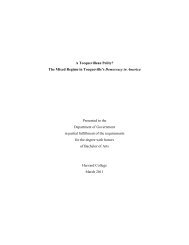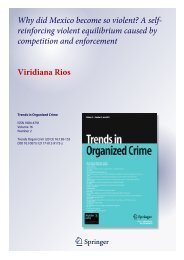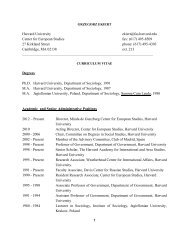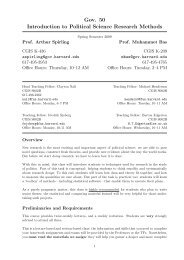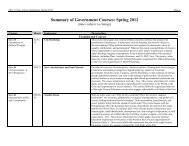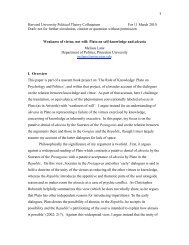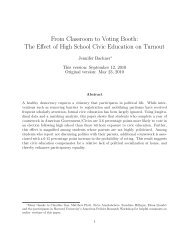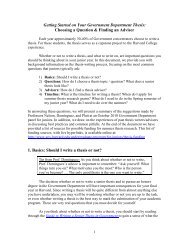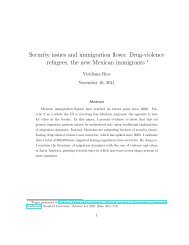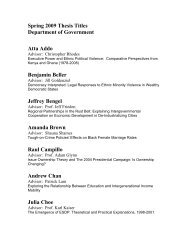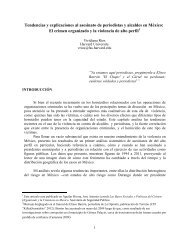Supreme Court Agenda Setting in a System of Shared Powers Ryan ...
Supreme Court Agenda Setting in a System of Shared Powers Ryan ...
Supreme Court Agenda Setting in a System of Shared Powers Ryan ...
You also want an ePaper? Increase the reach of your titles
YUMPU automatically turns print PDFs into web optimized ePapers that Google loves.
4 The Journal <strong>of</strong> Law, Economics, & Organization. V0 N0<br />
oppos<strong>in</strong>g review <strong>in</strong>creases (Caldeira and Wright, 1988; Caldeira, Wright and<br />
Zorn, 1999), when the lower courts are <strong>in</strong> conflict over the correct application<br />
or <strong>in</strong>terpretation <strong>of</strong> federal law, and when other important legal considerations<br />
exist.<br />
All <strong>of</strong> these studies have served to further our understand<strong>in</strong>g <strong>of</strong> the conditions<br />
under which the <strong>Court</strong> sets its agenda. Nevertheless, they tell us noth<strong>in</strong>g<br />
about whether congressional and executive preferences <strong>in</strong>fluence the manner<br />
<strong>in</strong> which the <strong>Supreme</strong> <strong>Court</strong> sets its agenda. Do congressional and executive<br />
preferences cause the <strong>Supreme</strong> <strong>Court</strong> to decl<strong>in</strong>e to review cases? In what follows,<br />
I address these questions.<br />
3. Expla<strong>in</strong><strong>in</strong>g Strategic SOP <strong>Agenda</strong> <strong>Sett<strong>in</strong>g</strong><br />
Exist<strong>in</strong>g studies which analyze whether the separation <strong>of</strong> powers <strong>in</strong>fluences<br />
the <strong>Court</strong> arrive at mixed conclusions with most, however, f<strong>in</strong>d<strong>in</strong>g no evidence<br />
<strong>of</strong> an SOP effect (Segal, 1997; Segal and Westerland, 2005; Sala and Spriggs,<br />
2004; Spriggs and Hansford, 2001). The few studies that observe an SOP <strong>in</strong>fluence<br />
are limited <strong>in</strong> important ways which make their conclusions somewhat<br />
suspect. For example, Hansford and Damore (2000) f<strong>in</strong>d that some justices<br />
moderate their votes based on legislative preferences. Analyz<strong>in</strong>g the <strong>Court</strong>’s<br />
statutory decisions from 1963 to 1995, the authors f<strong>in</strong>d that justices more conservative<br />
than the president and both judiciary committees cast more liberal<br />
votes than they would <strong>in</strong> a non-SOP context. On the other hand, liberal outlier<br />
justices were no more likely to rule conservatively to avoid legislative rebuke.<br />
These results do not square with the SOP model exam<strong>in</strong>ed however, as the<br />
model asserted that both types <strong>of</strong> outlier justices would behave strategically.<br />
Moreover, the study uses preference estimates for the different branches that<br />
do not scale, limit<strong>in</strong>g the f<strong>in</strong>d<strong>in</strong>gs. 3<br />
Spiller and Gely (1992) f<strong>in</strong>d that the <strong>Court</strong> renders more pro-labor decisions<br />
as Congress becomes <strong>in</strong>creas<strong>in</strong>gly liberal; yet, the study does not <strong>in</strong>clude the<br />
president as a pivotal actor and relies on ADA scores as proxies <strong>of</strong> legislative<br />
ideology. These scores have been attacked as poor surrogates <strong>of</strong> congressional<br />
preferences (B<strong>in</strong>der, Lawrence and Maltzman, 1999; Snyder, 1992).<br />
F<strong>in</strong>ally, Harvey and Friedman (2006) f<strong>in</strong>d that the 1994 Republican Revolution,<br />
which provided the <strong>Court</strong> with a friendly Congress, played a key role<br />
<strong>in</strong> the <strong>Court</strong>’s <strong>in</strong>creased proclivity to strike federal laws after 1994. Still, the<br />
substantive impact <strong>of</strong> their SOP variable is weak: The predicted probability<br />
that the <strong>Court</strong> would strike a federal statute <strong>in</strong>creased from 0.00036 <strong>in</strong> 1987 to<br />
0.00137 <strong>in</strong> 2000 as the result <strong>of</strong> the <strong>Court</strong>’s new position between key pivots<br />
<strong>in</strong> Congress. What is more, s<strong>in</strong>ce the study does not <strong>in</strong>clude the president as<br />
a pivotal actor (other than <strong>in</strong> the Filibuster-Veto model), it is unclear whether<br />
these results are the product <strong>of</strong> an artificially small legislative equilibrium. 4<br />
3. Justice ideology is measured as the percent <strong>of</strong> liberal votes a justice cast, while legislative<br />
and executive preferences are coded us<strong>in</strong>g DW-NOMINATE scores (see also Bergara, Richman<br />
and Spiller, 2003).<br />
4. The study is, however, an <strong>in</strong>terest<strong>in</strong>g piece with a unique approach to the separation <strong>of</strong>



